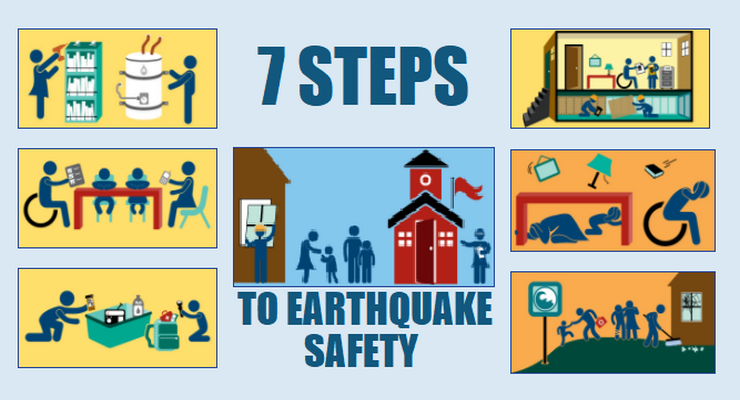
The American Red Cross Los Angeles Region urges Pasadenans to participate in the Great ShakeOut earthquake drill on Oct. 21. Join millions of people around the world to practice what to do during an earthquake. Drop. Cover and Hold On!
Los Angeles experiences an average of five earthquakes a year with magnitudes between 3 and 4. There have already been a few this year with the Big One predicted to strike at any time. The U.S. Geological Survey says there is a 31% likelihood of a magnitude 7.5 earthquake in Los Angeles in the next couple of decades.
We can’t stop an earthquake; we can prepare. On Thursday morning at 10:21 a.m. practice what you know about how to stay safe — find a table or sturdy furniture item; take cover; and hold on. Doorways providing protection is a myth.
“It’s not a matter of if, but when we have an earthquake. It’s going to happen and unfortunately, people get complacent. The more you practice and train the better off you’ll be when the situation occurs,” said Pasadena Fire Department Spokeswoman and Community Emergency Response Training (CERT) Coordinator Lisa Derderian.
Mark Benthian, Executive Director of the Southern California Earthquake Center offers some advice.
“What to do to protect yourself during an earthquake? Drop, cover, and hold on for most situations. That’s the best position to put yourself in even if there’s something with the building potentially collapsing — you’re likely to be in a spot that will be safe during an earthquake,” said Benthian..
According to the Earthquake Country Alliance which founded the statewide Great Shakeout drill in 2008, there are seven recommended steps to prepare for earthquake safety.
Step One is to secure your space by identifying hazards and securing moveable items such as bookcases away from beds, sofas, or other places where people sit, sleep, or spend a lot of time.
Several people died and thousands were injured in the 1994 Northridge earthquake because of unsecured items such as toppling bookcases.
According to a study from the University of California in Los Angeles (UCLA), 55 percent of the injuries during this earthquake were caused by falling furniture or objects.
Only one percent of injuries were caused by building damage. Other injuries were due to people falling or behaving dangerously. In addition, many billions of dollars were lost due to this type of damage, according to Earthquake Country Alliance.
Step Two is planning to be safe by creating a disaster plan and deciding how you will communicate in an emergency.
According to the Earthquake Country Alliance, Planning for an earthquake, terrorist attack, or other emergency is not much different from planning for a party or vacation.
Make sure that your emergency plan includes evacuation and reunion plans; your out-of-state contact person’s name and number; the location of your emergency supplies and other pertinent information. By planning now, you will be ready for the next emergency.
Step Three is to organize disaster supplies in convenient locations.
Everyone should have disaster supplies kits stored in accessible locations at home, at work and in your vehicle. Having emergency supplies readily available can reduce the impact of an earthquake, a terrorist incident or other emergency on you and your family.
Your disaster supplies kits should include food, water, flashlights, portable radios, batteries, a first aid kit, cash, extra medications, a whistle, fire extinguisher, etc.
Keep one kit in your home, another in your car, and a third kit at work. Backpacks or other small bags are best for your disaster supplies kits so you can take them with you if you evacuate.
Step Four is to minimize financial hardship by organizing important documents, strengthening your property, and considering disaster insurance.
To help you organize the most important information you will need, begin with designating a “grab-and-go” backpack or bag.
Consider what documents you will need if you are away from home for an extended time such as what you will need as identification, to reach loved ones, to file an insurance claim, etc. Put all of these important documents in a sealed plastic bag, then place it into your “grab-and-go” bag. Leave your “grab-and-go” somewhere you can get to easily.
Step Five is to drop, cover, and hold on when the earth shakes.
Step Six is to improve safety after earthquakes by evacuating if necessary, helping the injured, and preventing further injuries or damage.
The moment the ground stops shaking it is important take action quickly and safely. Evacuate to higher ground if a tsunami is possible.
If not, check for injuries and damages that need immediate attention. Use your training in first aid to assist those in need.
Look around your environment to identify any new hazards such as leaking gas lines, damage to the building, water or electric lines, or other things that may be dangerous, especially if there are aftershocks.
Be prepared to report damage to city or county government
Step Seven is to restore daily life by reconnecting with others, repairing damage, and rebuilding community.
Following a major disaster, communication will be an important step in your recovery efforts. Turn on your portable radio for information and safety advisories. If your home is damaged, contact your insurance agent right away to begin your claims process. For most Presidentially declared disasters, resources will also be available from federal, state, and local government agencies.
Your recovery period can take several weeks to months or longer.
For an in-depth guide of the Seven Steps to Earthquake Safety, visit http://www.earthquakecountry.org/sevensteps/.








